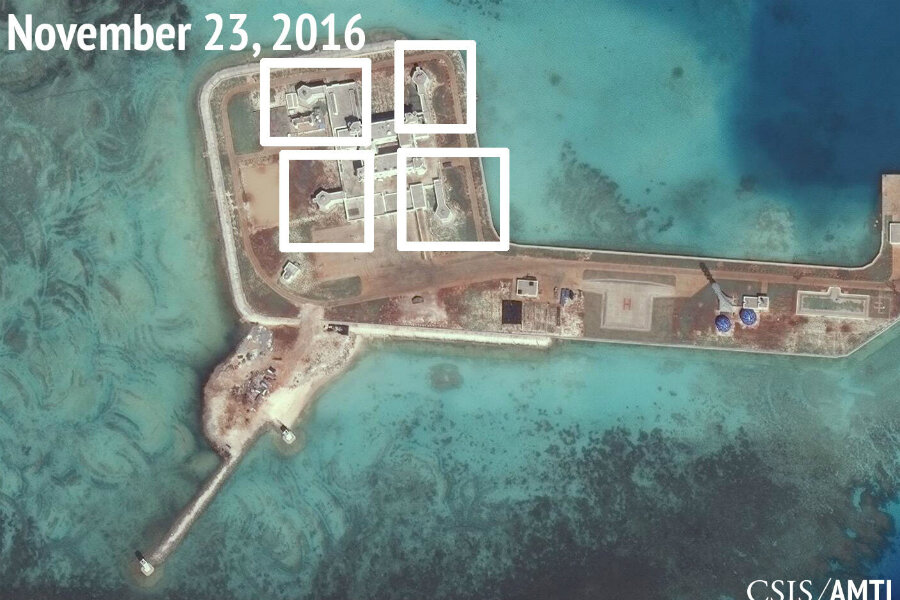How underwater drone could set tone for Trump's new relationship with China
Loading...
| Paris
It is not customary to steal an item from someone and then give it back as a Christmas gift, but that is what the Chinese are doing to the United States. And Beijing is acting as if it were the aggrieved party.
Last Thursday, Chinese sailors snatched a US underwater surveillance drone that the USNS Bowditch was trying to retrieve from waters in the South China Sea.
It marked “the first example ever of the blatant theft of US military property operating in international waters,” says Ashley Townshend, an international security expert at the University of Sydney.
“It’s a signal that China is still wedded to its ambitions and its expansive claims in the South China Sea, and willing to undertake provocative actions to support them,” he adds.
It also indicates the sort of challenge that Donald Trump is likely to face early in his term of office, testing his campaign pledges to get tough with China and setting the tone for Washington’s new relationship with China.
In this instance, the Americans publicly and forcefully asked for their drone back, and on Saturday the Chinese agreed to return it – but not before the Chinese Defense Ministry had complained that Washington was “inappropriately hyping” the incident.
The United States has been notably less successful in its repeated demands that China cease building artificial islands on reefs and shoals that several nations beside China claim.
Indeed, satellite photos released this week appeared to show that the Chinese military has installed antiaircraft and antimissile systems on all seven of the artificial islands it has created.
That would be a breach of China's President Xi Jinping’s promise to President Obama last year that China did “not intend to pursue militarization” of the strategically key trade route.
But the Chinese Defense Ministry, asked about the photos of new fortifications on the islands, issued a statement calling the military facilities “legitimate.”
“If someone is swaggering on your doorstep, can you not prepare a slingshot?” the statement asked.
That appeared to be a reference to the presence of US warships in the South China Sea, sailing close to the islands in “freedom of navigation” exercises designed to enforce foreign ships’ right to be in international waters, despite China’s disputed claims to most of the South China Sea.
Far from “swaggering,” however, says Tang Siew Mun, an analyst at the Institute of Southeast Asian Studies in Singapore, “Washington’s restrained response probably helped to prevent further escalation.”
The Trump outlook
But that approach may change in the upcoming Trump administration. What Dr. Tang calls “restraint,” Daniel Blumenthal calls “passivity,” and he thinks it is high time that the United States switch into a more active mode.
Mr. Blumenthal is head of the Asia program at the American Enterprise Institute, a conservative Washington think tank. He is also one of US President-elect Trump’s advisers on Asian affairs, reportedly tipped for office in the next administration.
“We are not going to knock the military facilities out,” he says. “But the US Navy can show that we can shut off replenishment of the islands, show that we do not respect the islands’ [Chinese] sovereignty.
“There are ways that the US Navy could demonstrate Chinese vulnerabilities,” Blumenthal adds, “different exercises you can do to show that you can isolate Chinese taskforces, to demonstrate that they are vulnerable far from their shores.”
How would the Chinese government react to such harassment? “I’d expect them to back off, as they do when they are confronted,” Blumenthal says.
That assessment is not universally shared. “We are at a dangerous inflection point,” worries Tang. “A strong response by … Trump will be met by a stronger response by China. The US should not start anything it cannot finish, otherwise its credibility will suffer even further.”
And anyway, it is probably too late to change the outcome in the South China Sea, now that the islands are built and well on the way to becoming military fortresses projecting Chinese hard power into Southeast Asia.
The sort of enhanced freedom of navigation operations that Blumenthal advocates – sending US vessels inside the 12-mile territorial limits that China claims around its artificial islands but that do not exist in international law – “won’t solve the problem and will raise tensions,” says Mr. Townshend.
More muscular operations close by the Chinese island bases might send the right message of defiance, but they won’t roll back the runways and they won’t deter more construction. If anything, Townshend says, such patrols might speed up the deployment of surface-to-air missiles and fighter jets.
A better way to check China’ ambitions to gain full control over the South China Sea and thus its routes into the Indian and Pacific oceans, Townshend suggests, would be to build the Japanese, Australian, Singaporean, and other allied navies into a network that would ensure a balance of power with Chinese forces.
Such plans took a knock this week, though, as the Philippines, long America’s most loyal ally in Southeast Asia, took another step toward China in a strategic U-turn that has shocked international observers.
Manila will not complain to China about the new military facilities, even those built on reefs that the Philippines claims, Foreign Secretary Perfecto Yasay told reporters. “Let them take whatever action is necessary in the pursuit of their national interest,” he said.








